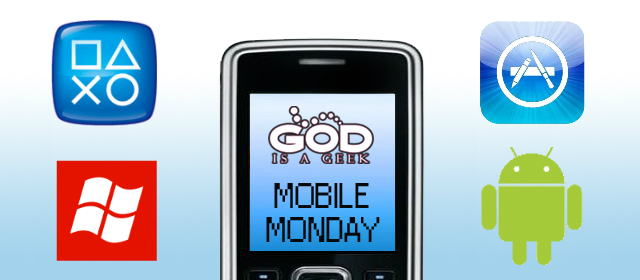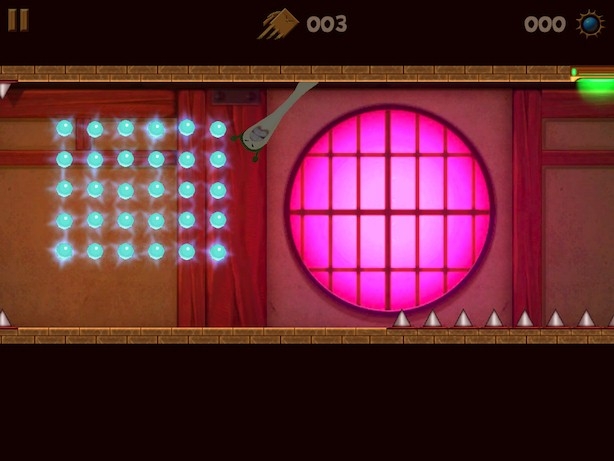Third week, third Mobile Monday roundup. That’s not too bad as far as I’m concerned. There have been plenty of games for you to play, hopefully you’ve taken the advice and played some of them, and there are many, many more yet to come. This week we’ve got a diverse selection of games for you to choose from, some of them puzzle games, some of them racing, some of them popular and some of them not so popular, but that’s what you come here for, right? To see what you could be missing, and we live to serve.
This week we’ve got Swing the Bat from Chillingo, Dash Race from Rombos and To-Fu 2 and Spacelings from HotGen. Give everything a read, see what you think you’ll like and spend the week playing them. Then come back, visit our forums and tell us what you thought.
Have a week!
Titles are available on iPhone and iPad unless specifically stated otherwise. If you like what you read, click the small black “App Store” button to load iTunes up and purchase the title!
![]() SWING THE BAT:
SWING THE BAT:
At first glance of the title of this game you’ll probably, as I did, mistakenly think that it’s some sort of baseball game, however, after your first few seconds of playing Deadbug’s addictive swinging game you’ll see that the game’s title is very literal indeed; you’ll be swinging a bat. Nothing more needs to be said really.
The gameplay revolves around a single control mechanic; tapping the screen. Doing this will allow the bat to grab on to the closest object and swing in an arc from that point, the main objective of the game is to get as far as you can while completing certain objectives. In order to get the best scores, players will need to be able to time their swings so that they’re letting go at the perfect moment (indicated by a green line), and launching themselves as far as possible into the distance, then grabbing another object and repeating the process. Once players get into the swing of things, pun totally intended, they will be swinging from tree to tree like a Tarzan with fangs, and it soon becomes a very enjoyable, and quite soothing experience.
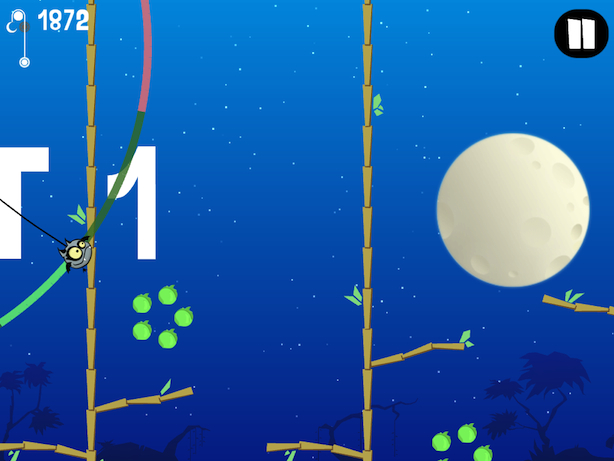
It
The control mechanic is one of the easiest on the iPad to pick up and master, and all the player is required to do in order to control the character is tap the screen, that’s it. Doing so will shoot out a little rope/grappling hook/something that the character then uses to swing, let go of the screen when you’re ready to let go of the rope/grappling hook/something and you’re well on your way to the next object that you’ll want to attach yourself to. When it comes to the controls of Swing the Bat the most difficult thing to master will be exactly when to detach yourself from the object, due to some hazards that litter the game world it’s not always wise to detach just when the bat is in the green area, you may need to go a little higher to get into a cave or touch the sky or you may need to get to the bottom of the area in order to complete an objective. Mastering the swing mechanic isn’t too difficult though, and it’s quite fun to learn too.
Swing the Bat makes use of a 2D animation style throughout the game, this helps the style of the game stay a little more down to earth and less complicating than it could have been. This style of animation also helps to make the whole game look a lot more crisp than it would have done otherwise and makes sure that it looks very sharp when displayed on the high definition screen of the iPad. Overall this makes Swing the Bat a very enjoyable game to play, and look at.
If you’re looking for a game that you can spend some time playing while you’ve got nothing else to do then Swing the Bat should be high up on that list. The gameplay can get a little repetitive after a while but that ability to unlock different costumes by doing different things always keeps it a little bit fresh. Any game that releases a universal app instead of separate iPad and iPhone version always deserves a little bit of extra praise in my opinion too. Nothing worse than buying the same app twice! Swing the Pad is one of those universal apps meaning that you can play it in its optimal form on the iPad and then take it with you on the iPhone without paying any extra. Who can complain at that? 

![]() DASH RACE:
DASH RACE:
While we’re in school we do a lot of things that we shouldn’t, playing games with each other during those times when we should be listening to the teacher is just one example of that. Dash Race takes its inspiration from one of those games that a lot of us would have played, or at least seen played, during those times (which is a while ago for some of us).
The crux of the gameplay within Dash Race centres on attempting to get to the end of the race quicker than your opponent, just like a standard racing game. What makes this game different from all those other games however, is the fact that you’re controlling the speed and direction of the car by using different lengths of lines. Each time your turn begins, your line is defaulted to the same length as your last turn, making the line one square shorter decreases your speed, while making it one square longer increases it. Steering is also accomplished using this system with the player choosing their direction by the directing of the line, left of the centre square and the “car” moves left and vice versa. This whole mechanic means that all players will have to be extremely tactical about when they’re going to slow down, turn and speed up. Adding to the fun for some people and frustrating others, depending on your preferred game style.
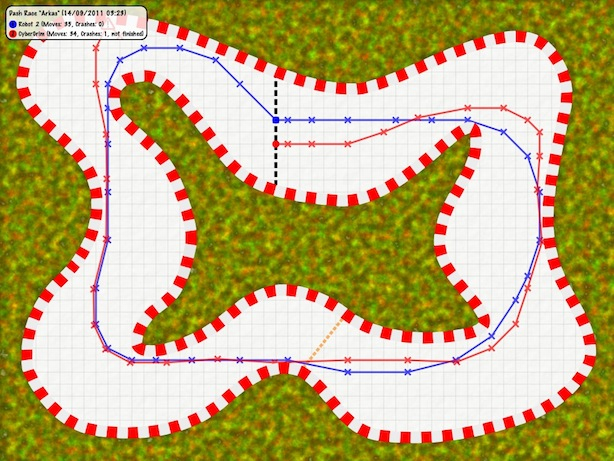
He raced circles around me 🙁
The visuals in Dash Race are one of the major let downs of the entire game, they manage to serve their purpose but they never manage to push the envelope, which is always a shame. The main game screen is ok, you’re basically given a piece of graph paper and asked to draw lines on it. The ability to save a picture of the track at the end of the race is a nice little touch too. The menus, for the most part look quite bad, mostly looking like something that you would expect from an application that hasn’t had much thought put into its design. Most people wouldn’t expect AAA design from such an inexpensive game, especially one based on such a simple premise, but menu buttons that at least show some form of reaction when they’re touched would have been a welcome addition.
The controls of Dash Race are extremely simple, the game can be a little difficult to grasp at first but once you manage it, the controls will pose very little problems. When it’s your turn to play simply tap and hold the screen to make a circle appear that will show your potential moves from that position. Choose to either stay at the same speed and direction or slow down, speed up or turn to your hearts content. Once you let go of the screen your choice will be made, for better or for worse, and your move will be taken. A nice addition to this control scheme is the fact that you can tap anywhere on the screen to bring up the potential moves, this means you’re never covering up anything important with your finger; something which a lot of games, some with a much higher production value, fall foul of.
In conclusion, if you’re the type of person who enjoyed this game during your school days then everything is here that you would expect, enabling you to continue those happy memories on a modern device (without the effort of having to steal squared paper from the maths classroom). If you’ve never even heard of the game before then it’s still worth a look, but it’s not as polished as some other games out there and the whole thing is a little bit lacking. 

![]() SPACELINGS:
SPACELINGS:
There’s never anything wrong with rescuing things, especially when those “things” are cute little green aliens. That’s exactly what Spacelings is; a game where the player is tasked with rescuing a plethora of little green men from the depths of space, bringing them back to your little spaceship before warping off to the next area to do the same thing over and over again. The game will already get a lot of people interested in buying it when they see the main characters, but when they see that it’s developed by a team who know exactly what they’re doing when it comes to addictive puzzle games then they should already know that they’re in for something worth at least a look.
In Spacelings you’re given the task of saving as many of the aliens as possible using the tractor beam of your spaceship. That may sound like an easy task, and for the first level or two it is, then the puzzle aspect of the game kicks in and things start ramping up pretty quickly. Players will have to figure out how to get the tractor beam around corners while destroying enemies and still getting to the aliens. Thankfully you only need to save a single alien in order to move on to the next level, but for the completists among you there are a lot more rewards for collecting all of them.
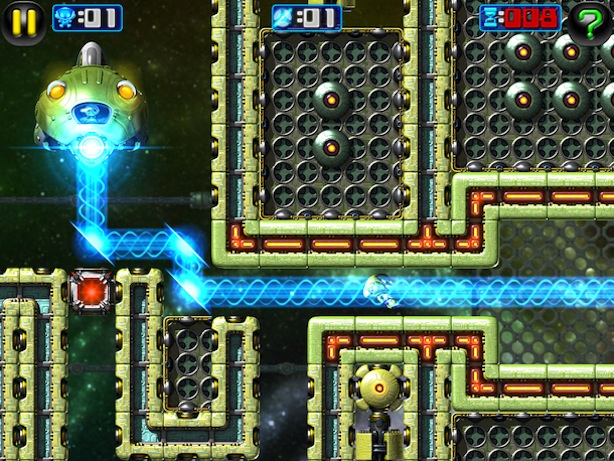
Tractor beams can go around corners now?!? Those “abductees” better be wary!
The visuals of Spacelings are pretty appealing for the most part, the menu system leaves a lot to be desired but once you’re in the actual game itself everything looks really well designed. The best looking aspect of the game is the spaceship itself, the small animation it does when it has collected all of the aliens on that level it can and it turns around and flies away is one of the best animations I’ve seen on the iOS platform and it really speaks to the quality of game you’re getting from HotGen. The aliens themselves look adequate, as do all of the enemies in the game, but once you’ve seen the quality of that spaceship, everything else seems to take a back seat because it just doesn’t look as good as that does.
The controls are very simplistic in Spacelings and require the player to only swipe the tractor beam in the direction that they want the beam to travel. Things start getting a little bit more complicated when you have to start thinking about deflecting things other than the tractor beam, but the best puzzle games are easy to learn and difficult to master, and Spaceling is no different in that respect. In later levels, players will need to be really quick in order to activate and deactivate the tractor beam in the correct order and at precisely the right moment in time, which can get slightly frustrating but you’ll never find yourself blaming the game’s controls, only yourself.
If you’re a fan of puzzle games then Spacelings deserves a look, it’s not one of the best ones out there but it serves its purpose. The cute little aliens coupled with the fact that there are a LOT of levels to get through means that even if it’s not your favourite puzzle game, after a little while playing with it you know that you’re at least getting your money’s worth. 

![]() TO-FU 2:
TO-FU 2:
How about a game that tasks the player to throw a piece of Tofu around the screen collecting blue orbs and smashing open Fortune Kittys? Sounds like a fever dream doesn’t it? Well, that didn’t stop the guys over at HotGen from developing it anyway. Twice. To-Fu 2 is the sequel to the popular environmental puzzle game To-Fu: The Trials of Chi and follows on in the same vein as the previous game with more puzzles, more extra features and more Tofu. Is it possible to have too much Tofu? Well, yes, but not too much To-Fu!
In To-Fu 2, just as in the first game, you’re tasked with collecting as many of the little blue orbs that litter the game world and then smashing the Fortune Kitty in order to complete the level. Each level has three potential goals that can be achieved, one for simply completing the level, another for collecting all of the orbs within each level and the last is achieved by completing the level in a set amount of “pings” or less. Thankfully these tasks don’t all have to be completed in a single turn and only one of them needs to be done in order to move onto the next level. Having them at all means that players that like to completely finish a level before they move on to the next will have plenty to do and literally hours of entertainment.
The visuals of To-Fu 2 are just as strong as they were with the first game. All of the environments and characters look sharp on the high definition display of the iPad, and To-Fu himself (and the strange face he pulls when stretched to his limit) looks good, as do all of the costumes that players are able to dress the main character up in. All of the animations that players will come across are smooth and play well, which all adds up to a very visually pleasing game to go on top of an already enjoyable gameplay experience.
The control scheme in To-Fu 2 is about as simple as you could imagine, drag To-Fu using your finger to stretch him and let go to shoot him across the screen and allow him to stick to whichever object he sticks to (as long as it’s not metal or glass). This particular control scheme is what most people would want to do at first glance of the game so it’s a method of controlling the game that is easy to pick up. The only down side to this type of control method is that some of the time the place where you’re trying to fling To-Fu to is obscured by your finger. This is more of a problem on the iPhone than on the iPad but it’s an issue nonetheless.
If you’re a fan of environmental puzzles then To-Fu 2 should be right up your alley, all of the puzzles are simple enough to complete while also being difficult enough to master that it will keep even the most astute puzzle gamer on their toes. Couple that with the crisp and clean visuals and the intuitive control scheme and you’ve got a game that should be able to contend with most of the other puzzle games on the iOS market for a place at the top of the game charts. The app itself is universal too, so if you’re wanting to play it at home or away you’ll only ever have to buy it once. Win/win then. 



